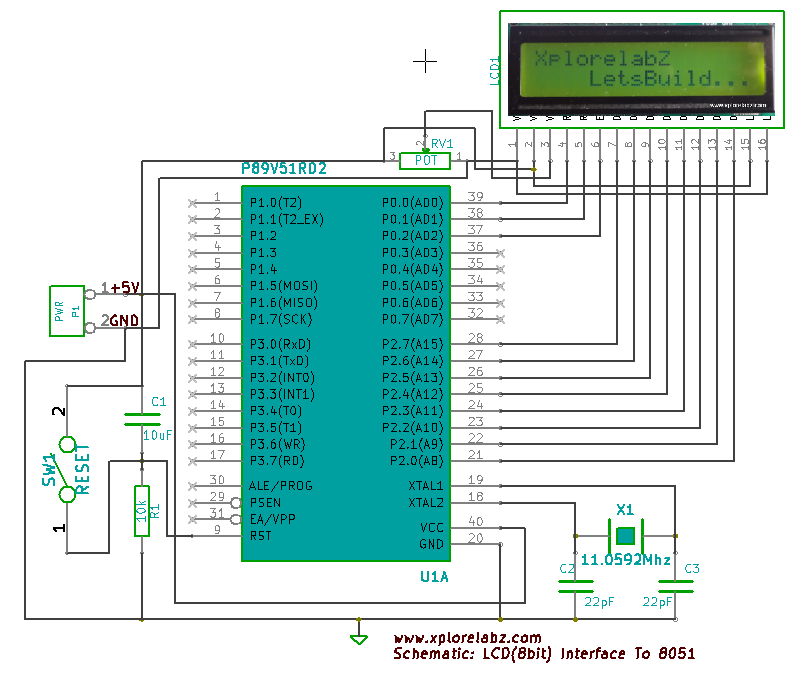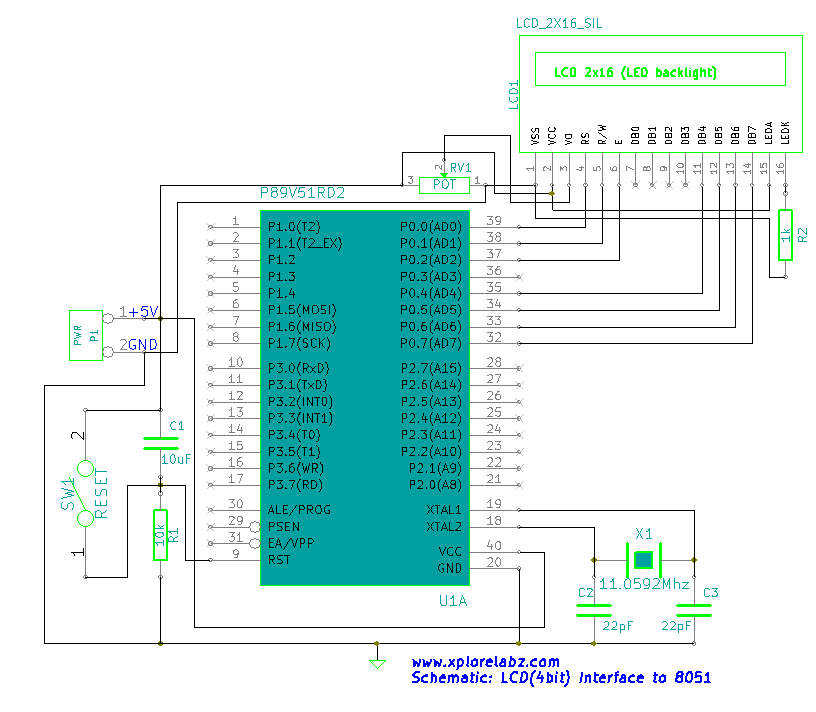Difference between revisions of "A1.8051 Interfacing:LCD 16x2"
| Line 328: | Line 328: | ||
[[File:8051 LCD8BIT Interface.PNG|Fig 3: Schematic LCD 8 bit mode]] | [[File:8051 LCD8BIT Interface.PNG|Fig 3: Schematic LCD 8 bit mode]] | ||
===Code=== | ===Code=== | ||
| + | {{scroll box|* Example 01* Example 02* Example 03* Example 04* Example 05* Example 06* Example 07* Example 08* Example 09* Example 10* Example 11* Example 12* Example 13* Example 14}} | ||
<syntaxhighlight> | <syntaxhighlight> | ||
/* Reg51.h contains the defnition of all ports and SFRs */ | /* Reg51.h contains the defnition of all ports and SFRs */ | ||
Revision as of 16:01, 21 December 2013
Contents
Introduction:LCD
Liquid Crystal Display(LCDs) provide a cost effective way to put a text output unit for a microcontroller. As we have seen in the previous tutorial, LEDs or 7 Segments do no have the flexibility to display informative messages. This display has 2 lines and can display 16 characters on each line. Nonetheless, when it is interfaced with the micrcontroller, we can scroll the messages with software to display information which is more than 16 characters in length.
LCD Internal Controller
The LCD is a simple device to use but the internal details are complex. Most of the 16x2 LCDs use a Hitachi HD44780 or a compatible controller. Yes, a micrcontroller is present inside a Liquid crystal display as shown in figure 1.
The Display Controller takes commands and data from a external microcontroller and drivers the LCD panel(LCDP). It takes a ASCII value as input and generate a patter for the dot matrix. E.g., to display letter 'A', it takes its value 0X41(hex) or 65(dec) decodes it into a dot matrix of 5x8 as shown in figure 2.
Basic Commands
The LCD controller uses RS and RW lines along with E to operate the LCD.
- Resister Select (RS): Determines weather a command(RS = 0) is sent (to set up the display) or actual data(RS=1) is sent.
- Read/Write RW=0; writes to the LCD. RW=1;Reads from the LCD.
The commonly used instructions are shown in the instruction set below. Observe the Bit names: I/D, S, D, C etc at the bottom of instruction set to decode the instructions completely.
- Clear Display
- Cursor Home
- Set Entry Mode
- Display on/off control
- Cursor/display shift
- Function Set
- Read Busy Flag
- Data Read
- Data Write
Instruction Set
| Instruction | Code | Description | ||||||||||
|---|---|---|---|---|---|---|---|---|---|---|---|---|
| RS | R/W | B7 | B6 | B5 | B4 | B3 | B2 | B1 | B0 | |||
| Clear display | 0 | 0 | 0 | 0 | 0 | 0 | 0 | 0 | 0 | 1 | Clears display and returns cursor to the home position (address 0). | |
| Cursor home | 0 | 0 | 0 | 0 | 0 | 0 | 0 | 0 | 1 | * | Returns cursor to home position. Also returns display being shifted to the original position. DDRAM content remains unchanged.
| |
| Entry mode set | 0 | 0 | 0 | 0 | 0 | 0 | 0 | 1 | I/D | S | Sets cursor move direction (I/D); specifies to shift the display (S). These operations are performed during data read/write.
| |
| Display on/off control | 0 | 0 | 0 | 0 | 0 | 0 | 1 | D | C | B | Sets on/off of all display (D), cursor on/off (C), and blink of cursor position character (B).
| |
| Cursor/display shift | 0 | 0 | 0 | 0 | 0 | 1 | S/C | R/L | * | * | Sets cursor-move or display-shift (S/C), shift direction (R/L). DDRAM content remains unchanged.
| |
| Function set | 0 | 0 | 0 | 0 | 1 | DL | N | F | * | * | Sets interface data length (DL), number of display line (N), and character font (F). | |
| Read busy flag & address counter |
0 | 1 | BF | CGRAM/DDRAM address | Reads busy flag (BF) indicating internal operation being performed and reads CGRAM or DDRAM address counter contents (depending on previous instruction). | |||||||
| Write CGRAM or DDRAM |
1 | 0 | Write Data | Write data to CGRAM or DDRAM. | ||||||||
| Write CGRAM or DDRAM |
1 | 0 | Write Data | Write data to CGRAM or DDRAM. | ||||||||
| Instruction bit names — I/D - 0 = decrement cursor position, 1 = increment cursor position; S - 0 = no display shift, 1 = display shift; | ||||||||||||
LCD UNIT
Let us look at a pin diagram of a commercially available LCD like JHD162 which uses a HD44780 controller and then describe its operation.
All the pins are identically to the lcd internal controller discussed above
| PIN NUMBER | FUNCTION |
|---|---|
| 1 | Ground |
| 2 | VCC |
| 3 | Contrast adjustment (VO) |
| 4 | Register Select (RS). RS=0: Command, RS=1: Data |
| 5 | Read/Write (R/W). R/W=0: Write, R/W=1: Read |
| 6 | Clock (Enable). Falling edge triggered |
| 7 | Bit 0 (Not used in 4-bit operation) |
| 8 | Bit 1 (Not used in 4-bit operation) |
| 9 | Bit 2 (Not used in 4-bit operation) |
| 10 | Bit 3 (Not used in 4-bit operation) |
| 11 | Bit 4 |
| 12 | Bit 5 |
| 13 | Bit 6 |
| 14 | Bit 7 |
| 15 | Back-light Anode(+) |
| 16 | Back-Light Cathode(-) |
Interfacing LCD with 8051
8 bit Mode
Schematic
Code
|
/* Reg51.h contains the defnition of all ports and SFRs */ #include <reg51.h> #include "lcd.h" //Xplore labz LCD library #include "delay.h" //Xplore Labz Delay library /* start the main program */ void main() { /* Initilize the lcd before displaying any thing on the lcd */ LCD_Init(); /* Display "hello, world" on first line*/ LCD_DisplayString("hello, world"); /*Go to second line and display "good morning" */ LCD_GoToLineTwo(); LCD_DisplayString("good morning"); while(1); }




